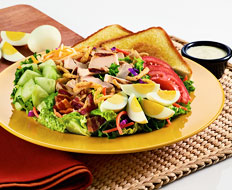The fast-casual category has been the fastest-growing restaurant segment over the past two years, according to market research firm Technomic, as operators in the category continue to effectively balance higher-quality, convenient foods with a more upscale environment.
This success has come even as fast casuals offer higher price points than traditional quick serves. A recent Technomic report found that consumers are happily paying more at fast casuals in both the lunch and dinner dayparts.
Technomic found that consumers believe the “optimal” price for a fast-casual lunch is between $7 and $7.60. Consumers are willing to pay above $7.60, but say that once the lunch price goes north of roughly $10, they will go somewhere else for their meal.
Meanwhile, consumers say $8.54 is their optimal price for a fast-casual dinner, only 14 cents lower than the dinner price they deem excessively high at traditional fast-food restaurants. In addition, the ideal fast-casual dinner price is higher than the optimal family-style dinner price of $7.86.
The data suggests that consumers may find fast-casual restaurants’ dinner fare and faster service style even more attractive than what family-style concepts offer in the evening, says Darren Tristano, executive vice president of Technomic.
“Dinner represents a valuable opportunity for fast-casual restaurants to differentiate themselves from competitors in multiple segments by meeting consumers’ higher expectations,” he says.
Fast-casual owners and operators say their customers appreciate higher-quality food, even if that means they’re paying more for their meals.
“There is a positive correlation between quality and nutrition that is recognized by our consumer demographic. Our menu is designed to appeal to quality-conscious consumers, who also recognize an excellent price-value relationship,” says Mark Given, director of operations for Woody’s Bar-B-Q, which has an average lunch check of $8 and an average dinner check of $12.
Blake Bailey, CFO of chicken fast casual Zaxby’s, where the average check is $9.81, says the brand is not “hyper-focused” on any specific dollar amounts, but rather on “offering premium product at an affordable price.”
That sentiment is shared by Ghazi Hajj, chairman and CEO of GrilliT—a new fast casual where fresh proteins are grilled in front of customers and the average price is $8.40–$8.85—as well as by Jim Mizes, president and COO of Blaze Pizza, the fast-growing pizza fast casual where individual pies cost between $5 and $7.45.
“Our guests tell us this is a great value,” Mizes says. “With a drink, their meal is around $10.” Blaze Pizza executives determined the ideal pizza price by evaluating fast-casual pizza and non-pizza competitors, and then evaluating the company’s food costs.
While many fast-casual operators have maintained fairly steady prices in recent years, Tristano says, the segment can withstand some price increases.
“Because fast-casual prices have been very modest to keep them competitive and well below casual-dining levels, the segment has a better opportunity to raise prices [than other segments],” he says. “Plus, the typical fast-casual consumer is higher income and less stressed by unemployment.”
Despite this, fast-casual operators say they are leery about any obvious retail price increase. “We are very careful about raising prices to our guests. We are going to raise operational efficiencies first,” says David Waters, Zaxby’s senior financial analyst.
Hajj similarly says that GrilliT has no plans to increase prices. “We weathered the recent price surge, and we will continue to evaluate strategies moving forward,” he says.
Fast-casual brands looking to boost their average checks without scaring away customers can do so by adding unique ingredients and beverages, Tristano says. For example, some operators have added an authentic side, dessert, or topping that drives up the average check but still offers a value for consumers.
“Fast casual has more options for items at higher price points,” Tristano says. “They use their menu mix as a way to increase check averages. For example, Chipotle added local beers, which is going to be a higher price point.”
Zaxby’s profits spiked after it rolled out a new salad this summer. To take its premium “Zalads” to another level, it added boiled egg, premium bacon, and a new salad dressing to its premium house salad and launched the “Cobb Zalad.”
“It is probably our most popular salad. It represents very high-quality, casual-dining presentation at very affordable pricing,” Waters says.
Likewise, Blaze Pizza benefitted from switching to unlimited toppings on its build-your-own pizzas last year and was able to increase its prices. In the past, customized pizzas were priced at $6.85 each and were limited to three meats and cheeses. The new build-your-own pizzas with unlimited toppings retail for $7.45 each.
“Our value proposition has gotten better, and guests love the ability to build their own pizza,” Mizes says.











